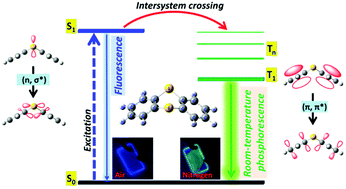Efficient room-temperature phosphorescence based on a pure organic sulfur-containing heterocycle: folding-induced spin–orbit coupling enhancement†
Abstract
The development of metal-free room-temperature phosphorescence (RTP) emitters is a very challenging task, due to one of the most critical issues in pure organic systems: very weak spin–orbit coupling (SOC). Herein, we report a novel mechanism of folding-induced SOC enhancement, which is mainly responsible for an efficient RTP of thianthrene (TA), a pure organic sulfur-containing heterocycle. In a rigid environment, SOC is significantly triggered by the folding along the S⋯S axis, arising from the orthogonality between the non-bonding pz-orbitals of the S atoms and the π-orbitals of the phenyl rings that results in a 1(n,σ*) transition configuration at the bend in essence. A single-molecule doped poly(methyl methacrylate) (PMMA) film of TA exhibits strong RTP emission once deoxygenated, which enables highly-sensitive oxygen-sensing. This work provides a novel strategy to design high-efficiency pure organic RTP materials using a folding-induced SOC enhancement mechanism.



 Please wait while we load your content...
Please wait while we load your content...